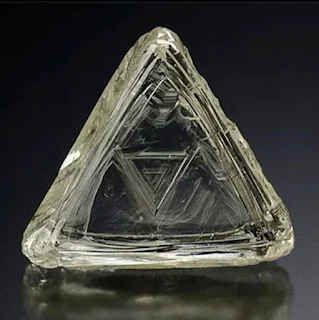When it comes to diamond growth, nature doesn’t always follow a straight path. One of the most intriguing results of this is the macle — a naturally occurring twinned diamond crystal with a unique triangular form.
What is a macle?
A macle forms when the crystal structure of a diamond shifts direction during growth. This shift causes a twinning effect, where two crystal sections share a plane but are rotated 60 degrees from each other. The result? A flattened triangle-shaped crystal, often resembling a shield or an arrowhead.
This twinning usually happens when the diamond begins to crystallize but deviates slightly from equilibrium, setting the stage for this unusual growth pattern.
How does it affect cutting?
Although twinned diamonds like macles can be cut like any other rough diamond, the twin plane often remains visible in the finished gem as a grain line. This line may not always be noticeable to the casual observer but is important during the cutting and polishing process.
Because of their shape, macles are less ideal for standard round cuts, but they’re well-suited for:
-
Trillion cuts
-
Heart shapes
-
Pear cuts
-
Or even left unpolished and set raw for a bold, natural look
Why it matters
Macles may not always be front and center in discussions about diamonds, but they offer a fascinating glimpse into the complexity of crystal formation. For cutters and collectors alike, these twinned formations are a reminder that even the most rigid materials can grow in surprisingly flexible ways.
Whether you're fascinated by gemology or just love a good diamond story, macles are a great example of how nature keeps things interesting.






